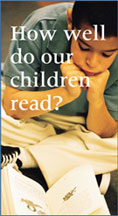What Is PIRLS?

- Compared to students in other countries, how well do our students read?
- Is reading achievement improving?
- Do our fourth-grade students value and enjoy reading?
- Do our students come from homes that foster literacy development?
- How is early reading instruction organized in our country’s schools?
- How do our teachers’ instructional practices compare with those of teachers in other countries?
Why Participate?
PIRLS 2006 is part of a five-year cycle of assessments that measures trends in children’s reading literacy achievement and policy and practices related to literacy. Countries that participated in PIRLS 2001 can obtain data about changes in children’s reading achievement. They also can collect valuable information about changes in reading instruction and how those changes relate to students’ performance in reading. Countries new to the study can collect baseline data about their students’ levels of reading achievement, as well as home, school, and classroom influences on that achievement.
Countries also participating in TIMSS 2003 or 2007 at the fourth grade will have information about reading literacy achievement that will complement the information collected about mathematics and science achievement and schooling.
For countries participating in OECD’s PISA, PIRLS’ focus on learning to read in primary school complements PISA’s emphasis on real-world competencies at the end of compulsory education, providing countries with data at two key points of schooling.
In summary, PIRLS provides trends and international comparisons on:
- Fourth graders’ reading achievement
- Students’ competencies in relation to goals and standards for reading education
- The impact of the home environment and how parents can foster reading literacy
- The organization, time, and materials for learning to read in schools
- Curriculum and classroom approaches to reading instruction.
Major Features
Framework
PIRLS is based on a comprehensive framework and specifications (see, for example, Framework and Specifications for PIRLS Assessment 2001). The PIRLS framework calls for students to be able to demonstrate their understanding of a wide variety of texts classified under two major purposes for reading – to acquire and use information and for literary experience. Within purposes, students are asked to engage in a full repertoire of reading skills and strategies, including:
- Focusing on and retrieving specific information
- Making straightforward inferences
- Interpreting and integrating ideas
- Examining or evaluating text features.
Encyclopedia
To provide a rich context for interpreting PIRLS results, each participating country contributes a chapter to the PIRLS Encyclopedia, describing the context for reading instruction in that country. The PIRLS 2001 Encyclopedia provides general information on the cultural, societal, and economic situation in each country, as well as a more focused perspective on the structure and organization of the education system as it pertains to the promotion of reading literacy.
Reading Test
The PIRLS test incorporates the latest approaches to measuring reading literacy. The selection of passages and the development of items and scoring guides are the result of an intensive process of collaboration, piloting, and review among the participants. The literary passages include realistic stories and tales, and the informational materials include continuous and non-continuous text. Passages and items are presented to students through 1-hour booklets including the PIRLS Reader, an attractive, full-color, magazine-style booklet. More than half of the questions are in the constructed-response format, requiring students to generate and write their answers.
Questionnaires
To provide a context for interpreting student reading achievement, PIRLS collects an extensive range of questionnaire data from the students as well as their parents, teachers, and school principals. By gathering information about children’s experiences in learning to read together with reading achievement on the PIRLS test, it is possible to identify factors or combinations of factors associated with high levels of reading literacy. Students complete questionnaires about their home and school experiences related to learning to read. Their parents and caregivers provide information about activities used to foster early literacy skills and their teachers and school administrators about instructional practices.
International Report & Database
Each participating country’s data are subjected to exhaustive checks for consistency and comparability across countries. Through a collaborative review process among countries, the results are described in the PIRLS International Report and made available in a well-documented and easily-accessible international database.
Management
Led by the TIMSS and PIRLS International Study Center at Boston College and the IEA Secretariat, the management consortium also includes Statistics Canada, the IEA Data Processing Center, and Educational Testing Service. The Reading Development Group (RDG), a panel of internationally-recognized experts in reading assessment and research, advises on framework and instrument development. Participating countries are fully involved through regular meetings of the National Research Coordinators (NRCs) and are responsible for managing and implementing assessment operations in their own countries.
Participation Fee
The international management of PIRLS is funded by the participating countries with support from the World Bank and the U.S. Department of Education’s National Center for Education Statistics. Although development and implementation of PIRLS 2006 will span nearly five years (see schedule), the participation fee for a country is US$30,000 per year for four years, or US$120,000 for the duration of the study.

